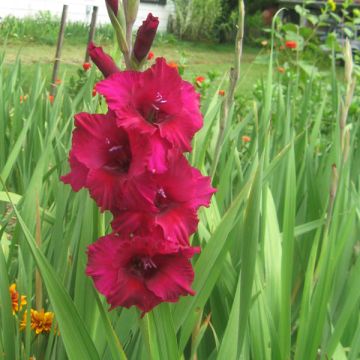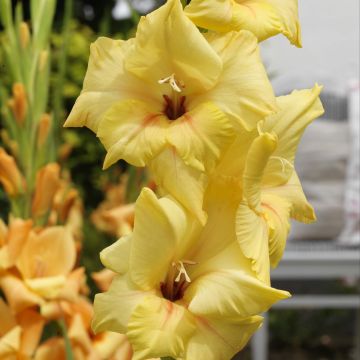

Gladiolus nanus Nathalie
Gladiolus nanus Nathalie
Gladiolus nanus (x colvillei) Nathalie
Sword lily 'Nathalie'
Planted some time ago, only 1 single bulb blooms each year out of the 20 purchased, quite disappointed considering that I place them sheltered from the wind against a wall and living close to the sea the climate is often mild so no frost. I don't understand why only 1 out of the 20.
Corentin, 15/05/2023
This item cannot be shipped to the selected country
Delivery charge from €5.90
More information
Schedule delivery date,
and select date in basket
This plant carries a 6 months recovery warranty
More information
We guarantee the quality of our plants for a full growing cycle, and will replace at our expense any plant that fails to recover under normal climatic and planting conditions.
From €5.90 for pickup delivery and €6.90 for home delivery
Express home delivery from €8.90.
Does this plant fit my garden?
Set up your Plantfit profile →
Description
Gladiolus nanus 'Nathalie' is a dwarf variety that creates a flowering whirlwind in late spring with beautiful salmon-pink blooms tinged with coral-red. It is of average hardiness and can remain in the ground in regions with mild winters. Its short stems can resist wind. Its silhouette is composed of graceful stems adorned with lively, light, and colourful flowers, like a flight of butterflies. It will find its place in natural gardens and undoubtedly in cottage gardens.
Cultivated gladioli are hybrids, belonging to the Iridaceae family. They are divided into 3 major groups: Grandiflorus (large-flowered), Primulinus (early-flowering), and Nanus (butterfly). 'Nathalie' belongs to the butterfly group. It blooms in June, before the large-flowered gladioli. These gladioli are characterised by their bright coloured spots reminiscent of butterfly wings. Each corm produces two or three slender spikes, 20 to 40cm (8 to 16in) long, bearing flowers 4 to 5cm (2in) in diameter. The subtle shades range from salmon-pink to cream, with a coral-pink spot. The foliage is tapering, sword-shaped, and glaucous green marked with purple at the base. The leaves are arranged in a fan, forming a clump 80cm (32in) tall.
Dwarf gladioli are hardier than large gladioli. In the garden, their elegant silhouette blends well with grasses and perennials with lighter blooms. Plant them in groups in borders with sage, tobacco plants, willowherb, bee balm, wallflowers, and forget-me-nots. They are perfect for cottage gardens. 'Nathalie' will look particularly beautiful planted in a large container. For bouquets, pick gladioli early in the morning when they have opened two or three flowers. Leave 5 to 6 leaves per stem to help the corm to continue its development. Remove the first two buds at the top of the flower stem. Plant at intervals every ten days in March/April. This way, you will have flowers all summer.
Gladiolus gets its name from the shape of its sword-like leaves, derived from the Latin word gladius.
Report an error about the product description
Plant habit
Flowering
Foliage
Botanical data
Gladiolus
nanus (x colvillei)
Nathalie
Iridaceae
Sword lily 'Nathalie'
Cultivar or hybrid
Other Gladioli
Planting and care
Gladiolus nanus 'Nathalie' appreciates light, deep, well-drained soils that are not too rich. Sandy soil is ideal. Plant it in full sun. Space the corms 10 to 15cm (4 to 6in) apart and cover them with 10cm (4in) of soil. Fertilise after cutting the flowers. Avoid using manure which causes bulb rot. Dwarf gladioli are less susceptible to frost than tall gladioli. They can overwinter in the ground if they are protected with a layer of straw, for example. Their short stems do not require staking. Cut the foliage to ground level once the plant is dry.
Planting period
Intended location
Care
-
, onOrder confirmed
Reply from on Promesse de fleurs
Bulbs to grow in pots
Haven't found what you were looking for?
Hardiness is the lowest winter temperature a plant can endure without suffering serious damage or even dying. However, hardiness is affected by location (a sheltered area, such as a patio), protection (winter cover) and soil type (hardiness is improved by well-drained soil).

Photo Sharing Terms & Conditions
In order to encourage gardeners to interact and share their experiences, Promesse de fleurs offers various media enabling content to be uploaded onto its Site - in particular via the ‘Photo sharing’ module.
The User agrees to refrain from:
- Posting any content that is illegal, prejudicial, insulting, racist, inciteful to hatred, revisionist, contrary to public decency, that infringes on privacy or on the privacy rights of third parties, in particular the publicity rights of persons and goods, intellectual property rights, or the right to privacy.
- Submitting content on behalf of a third party;
- Impersonate the identity of a third party and/or publish any personal information about a third party;
In general, the User undertakes to refrain from any unethical behaviour.
All Content (in particular text, comments, files, images, photos, videos, creative works, etc.), which may be subject to property or intellectual property rights, image or other private rights, shall remain the property of the User, subject to the limited rights granted by the terms of the licence granted by Promesse de fleurs as stated below. Users are at liberty to publish or not to publish such Content on the Site, notably via the ‘Photo Sharing’ facility, and accept that this Content shall be made public and freely accessible, notably on the Internet.
Users further acknowledge, undertake to have ,and guarantee that they hold all necessary rights and permissions to publish such material on the Site, in particular with regard to the legislation in force pertaining to any privacy, property, intellectual property, image, or contractual rights, or rights of any other nature. By publishing such Content on the Site, Users acknowledge accepting full liability as publishers of the Content within the meaning of the law, and grant Promesse de fleurs, free of charge, an inclusive, worldwide licence for the said Content for the entire duration of its publication, including all reproduction, representation, up/downloading, displaying, performing, transmission, and storage rights.
Users also grant permission for their name to be linked to the Content and accept that this link may not always be made available.
By engaging in posting material, Users consent to their Content becoming automatically accessible on the Internet, in particular on other sites and/or blogs and/or web pages of the Promesse de fleurs site, including in particular social pages and the Promesse de fleurs catalogue.
Users may secure the removal of entrusted content free of charge by issuing a simple request via our contact form.
The flowering period indicated on our website applies to countries and regions located in USDA zone 8 (France, the United Kingdom, Ireland, the Netherlands, etc.)
It will vary according to where you live:
- In zones 9 to 10 (Italy, Spain, Greece, etc.), flowering will occur about 2 to 4 weeks earlier.
- In zones 6 to 7 (Germany, Poland, Slovenia, and lower mountainous regions), flowering will be delayed by 2 to 3 weeks.
- In zone 5 (Central Europe, Scandinavia), blooming will be delayed by 3 to 5 weeks.
In temperate climates, pruning of spring-flowering shrubs (forsythia, spireas, etc.) should be done just after flowering.
Pruning of summer-flowering shrubs (Indian Lilac, Perovskia, etc.) can be done in winter or spring.
In cold regions as well as with frost-sensitive plants, avoid pruning too early when severe frosts may still occur.
The planting period indicated on our website applies to countries and regions located in USDA zone 8 (France, United Kingdom, Ireland, Netherlands).
It will vary according to where you live:
- In Mediterranean zones (Marseille, Madrid, Milan, etc.), autumn and winter are the best planting periods.
- In continental zones (Strasbourg, Munich, Vienna, etc.), delay planting by 2 to 3 weeks in spring and bring it forward by 2 to 4 weeks in autumn.
- In mountainous regions (the Alps, Pyrenees, Carpathians, etc.), it is best to plant in late spring (May-June) or late summer (August-September).
The harvesting period indicated on our website applies to countries and regions in USDA zone 8 (France, England, Ireland, the Netherlands).
In colder areas (Scandinavia, Poland, Austria...) fruit and vegetable harvests are likely to be delayed by 3-4 weeks.
In warmer areas (Italy, Spain, Greece, etc.), harvesting will probably take place earlier, depending on weather conditions.
The sowing periods indicated on our website apply to countries and regions within USDA Zone 8 (France, UK, Ireland, Netherlands).
In colder areas (Scandinavia, Poland, Austria...), delay any outdoor sowing by 3-4 weeks, or sow under glass.
In warmer climes (Italy, Spain, Greece, etc.), bring outdoor sowing forward by a few weeks.






















































